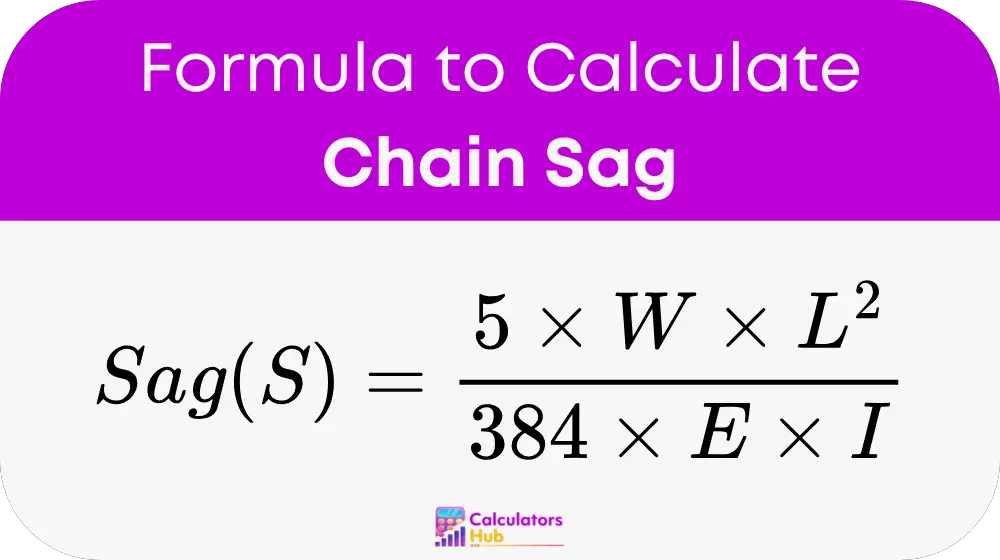The Chain Sag Calculator is a tool used to calculate the vertical sag or deflection of a chain in mechanical systems. Chain sag occurs when a chain hangs or stretches due to the weight or force applied to it, creating a downward curve between supports. This sag can impact the performance and efficiency of the system, leading to issues like excessive wear, misalignment, or power loss.
The Chain Sag Calculator provides a simple way to determine how much a chain will sag under a specific load, allowing engineers, technicians, and machine operators to ensure the system operates within safe parameters. By using this calculator, users can adjust the chain length, support positioning, or load to prevent excessive sag that might otherwise disrupt the operation.
Formula of Chain Sag Calculator
The formula for calculating chain sag is:

Where:
- Sag (S) = Vertical sag or deflection of the chain, typically in inches (in) or millimeters (mm).
- W = Load or force acting on the chain, in pounds (lbs) or Newtons (N).
- L = Length of the span between supports, in inches (in) or meters (m).
- E = Modulus of elasticity of the material, in pounds per square inch (psi) or Pascals (Pa).
- I = Moment of inertia of the chain, in inches⁴ or meters⁴.
This formula calculates the amount of vertical deflection a chain will experience under a specific load. By understanding these components, users can take steps to minimize sag, ensuring that the chain operates effectively without compromising system performance.
General Terms for Quick Reference
Here are some commonly searched terms and their units of measurement related to chain sag calculations:
| Term | Definition |
|---|---|
| Sag (S) | The vertical deflection or downward curve of the chain due to applied load. |
| Load (W) | The force or weight acting on the chain, typically measured in pounds (lbs) or Newtons (N). |
| Span Length (L) | The distance between the supports of the chain, measured in inches (in) or meters (m). |
| Modulus of Elasticity (E) | A measure of the material’s stiffness, given in pounds per square inch (psi) or Pascals (Pa). |
| Moment of Inertia (I) | A property that describes the distribution of the chain’s cross-sectional area, typically measured in inches⁴ or meters⁴. |
| Inches (in) | A unit of length commonly used in the imperial system, where 1 inch = 25.4 mm. |
| Meters (m) | A unit of length in the metric system, where 1 meter = 1000 millimeters. |
| Newtons (N) | A unit of force in the International System of Units (SI), where 1 N = 0.2248 pounds (lbs). |
This table helps users understand the key variables involved in the chain sag calculation, providing clarity on the terms and their associated units.
Example of Chain Sag Calculator
Let’s go through an example to better understand how to use the Chain Sag Calculator.
Given:
- Load (W) = 100 pounds (lbs)
- Span length (L) = 10 feet (ft)
- Modulus of elasticity (E) = 30,000,000 psi
- Moment of inertia (I) = 0.0004 in⁴
Step 1: Convert the span length into inches.
- 1 foot = 12 inches, so:
- Span length (L) = 10 ft = 10 * 12 = 120 inches.
Step 2: Apply the formula.
Sag (S) = ( 5 * W * L² ) / ( 384 * E * I )
Substitute the given values:
Sag (S) = ( 5 * 100 * 120² ) / ( 384 * 30,000,000 * 0.0004 )
Step 3: Perform the calculation.
Sag (S) = ( 5 * 100 * 14,400 ) / ( 384 * 30,000,000 * 0.0004 )
Sag (S) = 7,200,000 / 460,800 = 15.65 inches
Therefore, the vertical sag (deflection) of the chain is approximately 15.65 inches.
This example illustrates how to calculate the sag of a chain under a specific load using the Chain Sag Calculator formula. By knowing the sag, you can make adjustments to the system to ensure that the chain operates optimally.
Most Common FAQs
Chain sag occurs due to the weight or load acting on the chain, causing it to deflect between supports. The longer the span and the heavier the load, the greater the sag. Material properties, like the modulus of elasticity, also influence the extent of sag.
To minimize chain sag, you can reduce the load on the chain, decrease the span length between supports, or choose a material with a higher modulus of elasticity. Additionally, regular maintenance, such as lubrication and tension adjustments, can help reduce the risk of excessive sag.
No, chain sag is a vertical deflection due to weight or force, while chain stretch refers to the elongation of the chain over time due to wear or improper tension. Both issues can affect the performance of a chain, but they are caused by different factors.